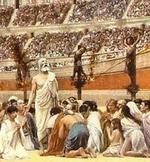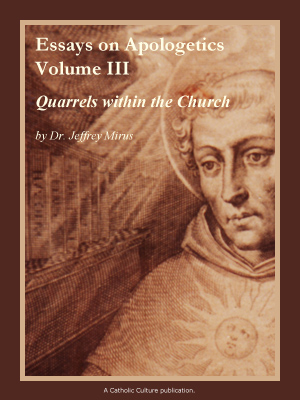Life Is Worth Living: The Message of Fulton Sheen
By Dr. Jeff Mirus ( bio - articles - email ) | Mar 11, 2019 | In Reviews
In the mid-1950s, Bishop Fulton Sheen became the Catholic voice of America with his groundbreaking television series, Life Is Worth Living. But there was a second series with the same title, recorded only in audio in 1965 and released just after the close of the Second Vatican Council. The television series was aimed at all men of good will in the larger secular culture. It lacked a clear sequential organization and was not always devoted to specifically Catholic topics. In contrast, the second series was deliberately intended to be a superbly organized guide to what Catholics believe and why.
There are a million stories about Fulton Sheen, some of which may well be apocryphal, but he told many of them himself. One story I heard many years ago involved a meeting with a young priest who had concluded that he was no longer suited to ministry. The priest carefully explained his loss of faith in the Eucharist. Sheen listened quietly for a time, but finally asked in response: “What color is her hair?” Whether this favorite story is true or not, the bishop had a way of getting to the heart of a question.
A famous personality admired by millions, Sheen remained convinced that the source of any effectiveness he had came from his daily holy hour before the Blessed Sacrament. There is now a cause for his canonization, and his native diocese of Peoria, Illinois has been at war for years with the Archdiocese of New York (where he is buried in St. Patrick’s Cathedral) for control over his remains. As of this writing, it looks like Peoria is going to win.
Yes, this is an unseemly battle over a holy man’s bones. But that’s a part of Catholicism too. Knowing the value of both intercession and relics, Catholics like to be close even to their potential saints.
Your Life Is Worth Living
The second and superior series, the audio series, was eventually transcribed for printing. Judging by the preface, it was first released (or prepared for release) in print around 2001. But Image Books (now an imprint of Penguin Random House) has just released a new edition under the title Your Life Is Worth Living with a foreword by Bishop Robert Barron. The book consists of 50 lessons, each about seven to eight pages long, which provide a secure foundation in the principle points of the Catholic Faith. There remain some obvious (very minor) transcription errors (and, sadly, Bishop Barron is identified as Robert “Barrow” on the title page), but though this is a fairly cheap edition, the material is solid gold, and deserves a place in your Catholic library. (Note: I have just learned that the original audio series is also still available, from the American Catholic Truth Society.)
What’s more, you’ll enjoy reading it. Sheen was a master at coming up with comparisons and analogies to help us to grasp the mysteries of the Faith, frequently building on our understanding of the natural order to demonstrate that God’s ways are not only consistent with reality as we know it but fundamentally comprehensible. It is this ability to explain the Faith in terms of our own human experience which makes the fifty lessons so enriching. While the purpose is primarily catechetical, the book is nothing like a catechism. Each lesson is really a delightful form of apologetics, explaining the faith in ways that give us reasons for hope (1 Pet 3:15).
The book is divided into five sections: God and Man; Christ and His Church; Sin; Sacraments; and World, Soul, and Things. The last section requires some explanation. It engages in a brief survey of the nature of the commandments and explores the four Last Things, but it also covers the mystery of sex, the evil of birth prevention, and marriage problems. The book closes with lessons on the feminine principle in religion, prayer, and “world, soul and things”—which essentially explores the nature of true human fulfillment. There is also a brief (and totally superfluous) study guide after the final lesson—not by Sheen.
Sheen’s Genius
Fulton Sheen was not only brilliant but deep; and not only brilliant and deep but extraordinarily well-schooled in philosophy and theology; and not only all of these things but incredibly widely read; and not only…well, he was a brilliant speaker and a fine writer as well. One of the delights found in a number of the lessons is Sheen’s surprising ability to introduce apt quotations from great literature to capture the essence of a point he has chosen to make. Scripture, of course, he uses constantly. But we also meet William Shakespeare, John Donne, Francis Thompson, Lewis Carroll, Kahlil Gibran, Elizabeth Barrett Browning, John Henry Newman and more.
Moreover some of his own explanations are almost epigrammatic. He talked about being a pencil in the hand of God before Mother Teresa did. To take just one more example, he explained worship this way: “Worship is our perfection, not God’s. To refuse to worship is to deny a dependence that makes us independent. Worship is to us what blooming is to a rose” (342).
Ultimately made an archbishop, his good humor was apparently unshakable. Commenting on birth prevention, he said:
Suppose a vast majority of people went around with their eyes blindfolded and their ears plugged up. We would soon have a Papal encyclical in opposition, and the Church would say, “It is not right to blindfold your eyes or to plug up your ears. Reason tells you the eyes were made for seeing and the ears were made for hearing. You must allow these organs to work out the function for which God created them.”
Many would say, “Oh, the Catholic Church is opposed to eye control.” “The Catholic Church is in opposition to ear control.”
Then there is his ability to enable us to understand even our own difficulties. Lesson 39 on “The Four Tensions of Love” is an astonishingly clear exposition of the reasons for and solutions to the tensions that give even the most dedicated married couples a great deal of trouble. Lesson 31 on “Sin” recognizes, even as early as the 1960s, the way our culture disguises the nature of sin, trying to eliminate its fruits through psychological denial and blame-shifting.
I could go on at considerable length, but I will close with just two more remarkable quotations. In Lesson 24 on “Sanctifying Grace” (another lesson I found particularly insightful), Sheen notices something:
In the book of the Apocalypse we read, You call yourselves living and yet you are dead (RV 3:1), meaning you are biologically alive but you are spiritually dead. We are constantly bumping up against walking corpses on the street. Their bodies are alive, but their souls are dead. As the life of the body is the soul, so the life of the soul is grace, or the partaking of the divine life. [201-202]
And in Lesson 15 on “Ascension”, he gives us an analogy and an image we can never forget:
[O]ur blessed Lord took upon Himself a pattern of human nature. Human nature was something like a die a government makes when it wishes to mint coins…. Christ, our pattern man, was born; He suffered, He overcame temptations, and He rose from the dead and was glorified at the right hand of the Father. We are the coins...and once our life is patterned upon his Crucifixion, then our life shall be patterned upon his glorious Resurrection and His glorious Ascension. Are we His coins? He will ask for coins and He will say, “Whose inscription is there on it, is it Caesar’s?” Do we belong to the world, or do we belong to God?
Your Life Is Worth Living is available in an inexpensive paperback and as an ebook. Get your copy and mark favorite insights as you read. That’s what I did.
All comments are moderated. To lighten our editing burden, only current donors are allowed to Sound Off. If you are a current donor, log in to see the comment form; otherwise please support our work, and Sound Off!








